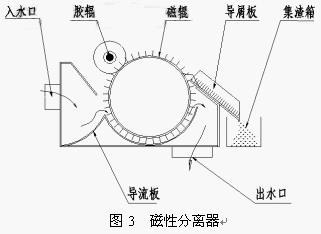Brief description of filtration and purification treatment methods for machine cutting fluids (2)
6. Filtration purification type of cutting fluid Figure 1 sedimentation tank Figure 2 Scraper type sedimentation tank 3) Centrifugal separator: The centrifugal separator is based on the difference in specific gravity between the cooling lubricant and the chip, and centrifugal force is generated by the high-speed rotation of the separator to separate the chips. Oil and water are also separated according to the difference in specific gravity of the different liquids. The purification process is that the cooling lubricating liquid with fine particles enters the inside of the rotor from the dirty liquid pipe, and rotates with the rotor at a high speed, and the centrifugal force generated by the rotation causes the fine particles to be thrown toward the wall, and the clean liquid overflows from the top. When there is too much chip accumulation inside the separator rotor, stop the filtration and clean the rotor. See Figure 4. The performance of the separator is determined by its number of revolutions and radius of gyration. Manual unloading and semi-automatic unloading centrifugal separators are used for the purification of emulsions, synthetic fluids and low viscosity cutting oils. The centrifugal separator has high separation precision, but high-speed rotation is prone to bubble generation, so it is not suitable for large-capacity separation. Previous page next page
The filtration and purification of cutting fluid can be roughly divided into two categories: filtration and separation, but they are often used in combination in actual production.
6.1 Separation device:
1) Sedimentation tank: As shown in Figure 1, there are separation baffles and partitions in the sedimentation tank to separate suspended solids and oil slicks. Chips and solid dirt are deposited on the bottom of the tank. The cleaning liquid which precipitates and isolates the floating material and the oil slick flows through the liquid storage portion of the sediment tank above the separator. This device is suitable for purifying the chips and wear debris of various cutting fluids, especially for chip separation and large chip separation. Figure 2 is another settling tank with a scraper chain that scrapes fine chips and solid dirt deposited on the bottom of the tank out of the tank and into the dirt box. It is suitable for the centralized cooling system of water-based cutting fluid. It is especially suitable for purifying the grinding fluid when grinding cast iron. The sedimentation tank has poor separation effect on chip fines, fine particles and high viscosity cutting oil. 

2) Magnetic separator: The magnetic separator has been used in the grinding process to purify the grinding fluid. It uses the principle of magnetic adsorption to remove iron filings and other magnetically conductive metals by means of a continuously rotating drum. Separation process: When the dirty grinding fluid flows through the slowly rotating drum adsorption zone, the magnetic solid particles are magnetized under the action of the magnetic field, adsorbed to the surface of the drum, and taken out of the grinding fluid flow zone, and pressed by the rubber. The roller is squeezed and dehydrated, and then the abrasive scraps on the drum are scraped off by means of a scraper attached to the drum. This magnetic separator can also remove some of the other non-magnetic impurities while separating the magnetic solid particles. See Figure 3. It is suitable for the purification of emulsions, water-based synthetic fluids and low-viscosity cutting oils. 

